In American Quarterly Volume 66, Issue 1 (March 2014), Ernesto Chávez assembled a forum on “Dimensions of Empire and Resistance: A Forum on the Past, Present, and Future of U.S. (Un)Equal Rights.” The page includes interactive features provided by several of the forum authors that draw from and elaborate upon the points made in their articles. Explore the supplementary content from this issue.
 In American Quarterly Volume 66, Issue 1 (March 2014), Ernesto Chávez assembled a forum on “Dimensions of Empire and Resistance: A Forum on the Past, Present, and Future of U.S. (Un)Equal Rights.” Assembled below are interactive features provided by several of the forum authors that draw from and elaborate upon the points made in their articles. This supplementary webpage begins with its own introduction by Ernesto Chávez and is followed by contributions from authors José Fusté, Koritha Mitchell, Tom I. Romero II, and Meg Wesling. To read the forum in its entirety, including author’s essays that are mentioned here, please see the print version of the issue.
In American Quarterly Volume 66, Issue 1 (March 2014), Ernesto Chávez assembled a forum on “Dimensions of Empire and Resistance: A Forum on the Past, Present, and Future of U.S. (Un)Equal Rights.” Assembled below are interactive features provided by several of the forum authors that draw from and elaborate upon the points made in their articles. This supplementary webpage begins with its own introduction by Ernesto Chávez and is followed by contributions from authors José Fusté, Koritha Mitchell, Tom I. Romero II, and Meg Wesling. To read the forum in its entirety, including author’s essays that are mentioned here, please see the print version of the issue.
- Dimensions of Empire and Resistance: A Forum on the Past, Present, and Future of U.S. (Un)Equal Rights, Ernesto Chávez
- No More Shame! Defeating the New Jim Crow with Anti-lynching Activism’s Best Tools, Koritha Mitchell
- Observations on History, Law, and the Rise of the New Jim Crow in State-Level Immigration Law and Policy for Latinos, Tom I. Romero, II
- Unsettling Citizenship/Circumventing Sovereignty: Re-examining the Quandries of Contemporary Colonialism in the U.S. Black Puerto Rican Anti-racist Thought, José I. Fusté
- The Unequal Promise of Marriage Equality, Meg Wesling
Dimensions of Empire and Resistance: A Forum on the Past, Present, and Future of U.S. (Un)Equal Rights
Ernesto Chávez
This American Quarterly forum, “Dimensions of Empire and Resistance: A Forum on the Past, Present, and Future of U.S. (Un)Equal Rights,” grew out of a panel at the American Studies Association Conference in San Juan, Puerto Rico in November 2012. The impetus for the panel was what I viewed as unevenness when it came to the doling out of rights in this second decade of the twenty-first century. Namely, the retraction of rights for people of color via discriminatory legislation like Arizona’s HB 1070, and the granting of privileges to gays and lesbians via the vehicle of marriage equality. To round out this portrait of (un)equal rights in the United States I thought it was important to include a discussion of African American and Puerto Rican experiences. The result was a stellar set of papers, and now essays, that placed these myriad occurrences in dialogue and in turn serve as a means to capture these “flashes of memory.”
Although the authors of these pieces, and indeed the conference itself, were guided by a vision of the American Empire as a singular entity, current events seem to show its fracturing. The proposed laws and those statutes in place that impinge on people of color and other minorities are for the most part emerging from the states (although they are being aided by the US Supreme Court, which recently gutted key provisions of the Voting Rights Act). Among these are Arizona’s HB 1070, which targeted Latino/a immigrants, the various voter I.D. laws in places like Texas and South Carolina, and of course Florida’s “Stand Your Ground,” which although not specifically aimed at aggrieved communities of color, was used as a defense in the George Zimmerman and Michael Dunn trials (accused of killing Trayvon Martin and Jordon Davis, respectively). The latter resulted in an attempted murder conviction, but a hung jury on the first-degree murder charge in the killing of Davis, and perhaps will cause others to think twice before using a firearm to defend themselves against rock throwing and the playing of loud music by African American youths. While some states are passing legislation negating rights, California is expanding the entitlements of its citizens, and indeed redefining citizenship as is evidenced by the Golden State’s issuing of driver’s licenses to the undocumented, and the acceptance of Sergio García, an unsanctioned immigrant, into the state bar. Although California seems to be the exception when it comes to extending rights to Latinos and other “illegal” immigrants, when it comes to marriage equality, there has been a flourishing of states that have recently allowed gay marriage, or who will no doubt do so in the near future, including traditionally conservative places like Utah and Virginia.Yet at the same time, Arizona seems to once again be at the forefront of the retraction of rights as is clear with the recent passage of the twin bills SB 1062 and HB2153, which would have allowed anti-gay discrimination based on religious grounds. Although Governor Jan Brewer vetoed the proposed legislation, it serves as a powerful coda for this forum, bringing together the issues that first prompted this discussion and making evident that the “other” is constantly redefined and with it so too are means of (in)equality.
As with all recent events, we can never be sure what impact they will have on the future. However it is my hope that by thinking about the connections between these different types of issues concerning civil rights, we will be prepared for what lies ahead. The forum participants, Koritha Mitchell, Tom Romero, José Fusté, and Meg Wesling offer their own “Beyond the Page” links. The following are some of my own aimed at making us think a bit more about the issues discussed in my introduction.
Related Links
These two stories from the New York Times, by the same author, on the same day, show how retraction and granting of rights occurring simultaneously:
- Adam Liptak, “Supreme Court Invalidates Key Part of the Voting Rights Act,” New York Times, June 26, 2013
- Adam Liptak, “Supreme Court Bolters Gay Marriage with Two Major Rulings.” New York Times, June 26, 2013
Two weeks later the Zimmerman case was decided, as reported by the New York Times:
- Lizette Alvarez and Cara Buckley, “Zimmerman Is Acquitted in Trayvon Martin Case,” New York Times, July 14, 2013
New Yorker legal analyst Jeffrey Toobin offers a comment on the use of “Stand Your Ground” in the George Zimmerman and Michael Dunn trials in the magazine’s blog.
Sean Sullivan, “Everything You Need to Know about 'Stand Your Ground' Laws,” Washington Post, July 15, 2013
The New York Times problematized the acceptance of Sergio García into the California State Bar: Jennifer Medina, “California Gives Expanded Rights to Noncitizens,” New York Times, September 21, 2013
The Center for Arizona Policy’s website and its justification of the Grand Canyon St HB 2315 offer a rich insight into narrow-minded thinking.
No More Shame! Defeating the New Jim Crow with Anti-lynching Activism’s Best Tools
Koritha Mitchell
This essay identifies similarities between racial violence of an earlier time period, lynching, and its most efficient form today, mass incarceration, suggesting that today’s racial violence be met with tools used by previous generations. I call for a critical demeanor of shamelessness that allows targeted communities and their allies to avoid taking on the shame that mainstream discourse encourages them to accept. People of color are incarcerated in staggering numbers, but not because they are disproportionately guilty of violent or even nonviolent crimes. Given the extreme racial disparities, being caught by the nation’s criminal (in)justice system is simply not a reflection of one’s character, not a reason for shame. Americans of all backgrounds must educate and empower themselves to see that truth—because mass incarceration fuels an empire whose greed knows no bounds, as it insists upon practices that allow the elite to make pawns of everyone else.
Left of Black: Season 2, Episode 14
I began seeing the connections between lynching in the 1880s through the 1920s and today’s prison-industrial complex when I was interviewed by Mark Anthony Neal shortly after the publication of my book Living with Lynching. Interview on Left of Black begins at 14:00.
The racial violence of mass incarceration is anything but “black and white.” Word count limits forced me to simplify, so I want to elaborate on what I mean when I say in the article, “Misrepresentation amounts to character assassination for people of color, but it also encourages property violence and physical violence; this tendency has animated American culture since Europeans slaughtered Native American ‘savages.’”
Racial violence shaped much of this country’s history and laid the foundation for a political present in which no matter what crimes have been committed against people of color, they are taught to be ashamed and to be hesitant about making public demands. Native Americans lived here long before Europeans arrived, and Europeans dealt with that reality by robbing indigenous people and butchering their loved ones. Yet, when survivors of indigenous sovereign nations assert themselves today, they are often considered unreasonable. Meanwhile, missing the irony, many who oppose immigrants of color, especially Latinos, do so based on the idea that whites have been here longer. Of course, Latinos have lived in this country for generations, but they are supposed to understand when others assume them to be foreigners and “takers.” In the late 1800s, to keep whites from having to compete with Chinese laborers and entrepreneurs, the nation’s leaders passed the Chinese Exclusion Act. In the 1940s, Japanese Internment not only robbed Japanese Americans of their freedom but it also allowed others to take their property. Nevertheless, all Americans are taught that the truest citizens, the ones who pulled themselves up by their bootstraps, were white. Throughout this country’s history, those perceived as white have murdered, attacked, and stolen from people of color, but people of color are said to be the criminals everyone should loathe, if not fear.
It has been promising to see a movement to decriminalize drugs. However, the need for a rigorous analysis of race and racism remains urgent. The Nation published a powerful forum making exactly this point. In addition to Katrina vanden Heuvel’s opening article, “Why It’s Always Been Time to Legalize Marijuana,” be sure to see Carl Hart’s contribution, “Pot Reform’s Race Problem.”
As is always the case with marginalized populations, those targeted by the violent discourses and practices of mass incarceration have been advocating for themselves. Calls for allies to join them emerge from a recognition that solidarity matters, but people should never assume that marginalized groups are simply waiting for saviors. Scholars such as Angela Davis and Michelle Alexander often highlight the work of remarkable organizations that could use more support and that deserve more visibility. For example, All of Us or None is an organization that recently won a long battle to have questions about prior convictions removed from California state employment applications. Alexander often posts such developments and other helpful information on her Facebook page.
As Angela Davis and Michelle Alexander often argue, dismantling the prison-industrial complex requires a broad, cross-racial, cross-class coalition. Mass incarceration hurts us all. When white Americans, including college students, joined the Occupy Movement in significant numbers, citizens received a vivid reminder that whites who do not behave as elites demand will be actively criminalized. Partly because he understands these kinds of tactics, and the coalitions required to make criminalizing strategies less effective, MSNBC anchor Chris Hayes consistently discusses the inherently unfair treatment American residents of all stripes receive.
Hayes’s insistence upon addressing these issues suggests his willingness to encourage white, middle-class Americans to see that criminalization often has more to do with color than behavior … and to support those facing unjust criminalization more often than they are. For example, he recently challenged another white male commentator’s characterization of drug use in order to underscore that the criminal justice system is shuttling some young people into college and others into prison:
Another way of understanding the urgency of abolishing prisons has emerged from the work of Dean Spade, author of Normal Life, and is concisely articulated in the video essay “Impossibility Now.”
In this short American Quarterly piece, I most frequently reference Angela Davis and Michelle Alexander, but there are many more scholars and activists committed to this work. In fact, there is a caucus devoted to these issues within the American Studies Association. If you are an ASA member, please consider affiliating. Other organizations include Critical Resistance: Beyond the Prison Industrial Complex and The Real Cost of Prisons Project.
Also very worth following is the Prison Culture Blog, maintained by Mariame Kaba, who is active on Twitter through the handle @prisonculture. In addition to the blog, please see her historically grounded essay “Laura Scott, Negress, Prisoner #23187,” the full text of which is available online.
Finally, an excellent week-long forum on mass incarceration appeared in The Feminist Wire the week of Martin Luther King, Jr. Day 2014. The forum, co-edited by Tanisha C. Ford and Hakima Abbas, includes original works by Angela Davis and Mumia Abu-Jamal and many others.
Observations on History, Law, and the Rise of the New Jim Crow in State-Level Immigration Law and Policy for Latinos
Tom I. Romero, II
The essay briefly examines the history of local enforcement of immigration law and policy against Mexican migrants and Mexican American citizens and its relationship to current legal struggles over immigration law and policy. Situated against the backdrop of anti-immigration efforts such as SB 1070 in Arizona and copycat legislation in other states, the essay argues that local and state level immigration enforcement has contributed to the creation and perpetuation of what Michelle Alexander in her book, The New Jim Crow: Mass Incarceration in the Age of Colorblindness, has described as a redesigned caste system in the United States. As state and local government authorities then and now sought to define and respond to the “Mexican menace” as the failed enforcement of federal immigration law, such law local ordinances and state statutes created legal and social conditions remarkably similar to the Jim Crow ordinances and state statutes that perpetuated and justified racial discrimination and unequal treatment against African Americans in the years and decades after the Civil War. A local or state government’s attempt to police and deport the “illegal alien” with the use of its county sheriffs, the state patrol, or its national guard highlighted the problematic extent that local and state governments exercised it most disciplinary powers of sovereignty (policing) against Latinos, subject to the most minimal standards of judicial review (immigration law). In the end, the essay highlights the many ways that immigration law and policy has completely effaced its contribution to the creation and maintenance of a racialized system of social control in the modern United States.
Related Links
Below are newspaper and other images from Colorado’s Depression Era “war” Against the “Mexican Menace” that I detail extensively in Tom I. Romero II, “A War to Keep Alien Labor out of Colorado: The ‘Mexican Menace’ and the Historical Origins of Local and State Anti-immigration Initiatives,” in the forthcoming Strange Neighbors: The Role of States in Immigration Policy, ed. G. Jack Chin and Carissa Hessick (New York: New York University Press, 2014).
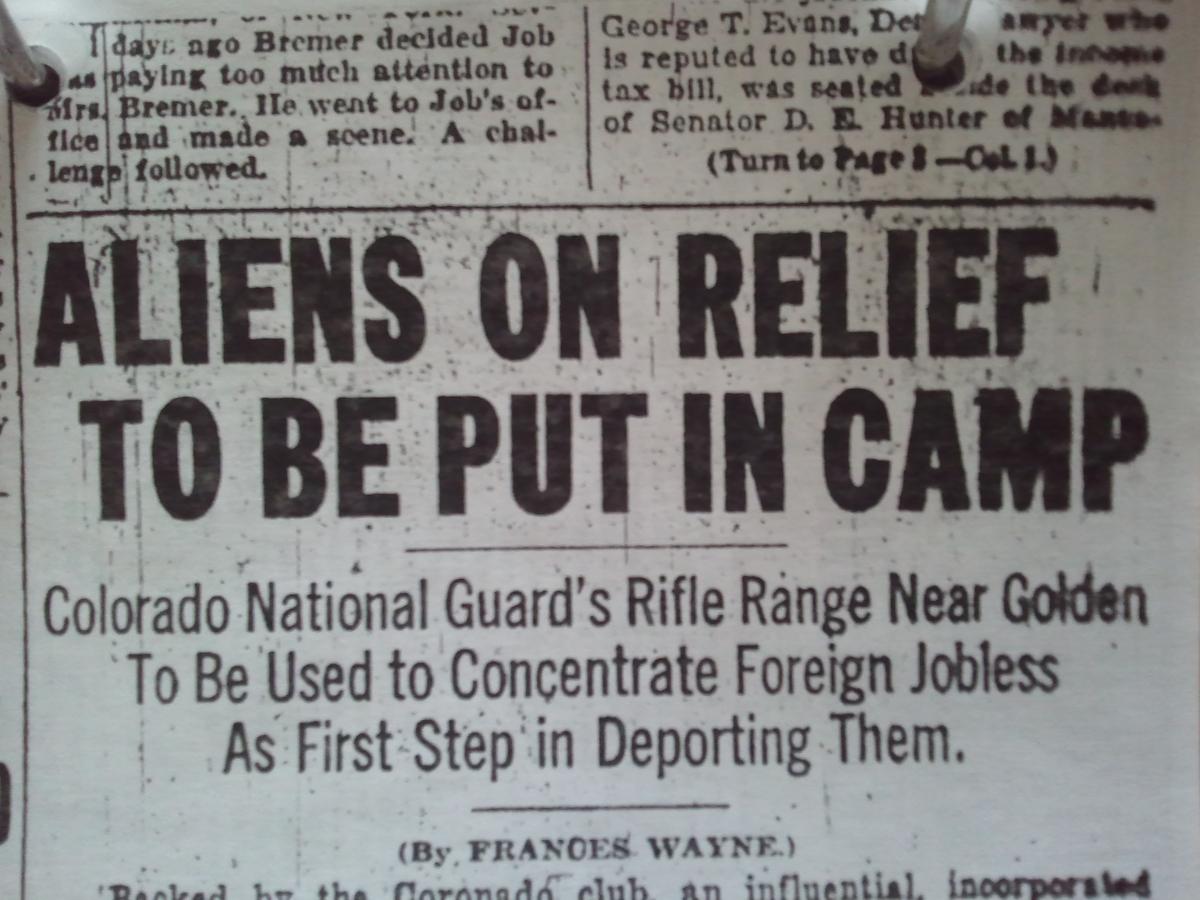
Denver Post, March 27, 1935
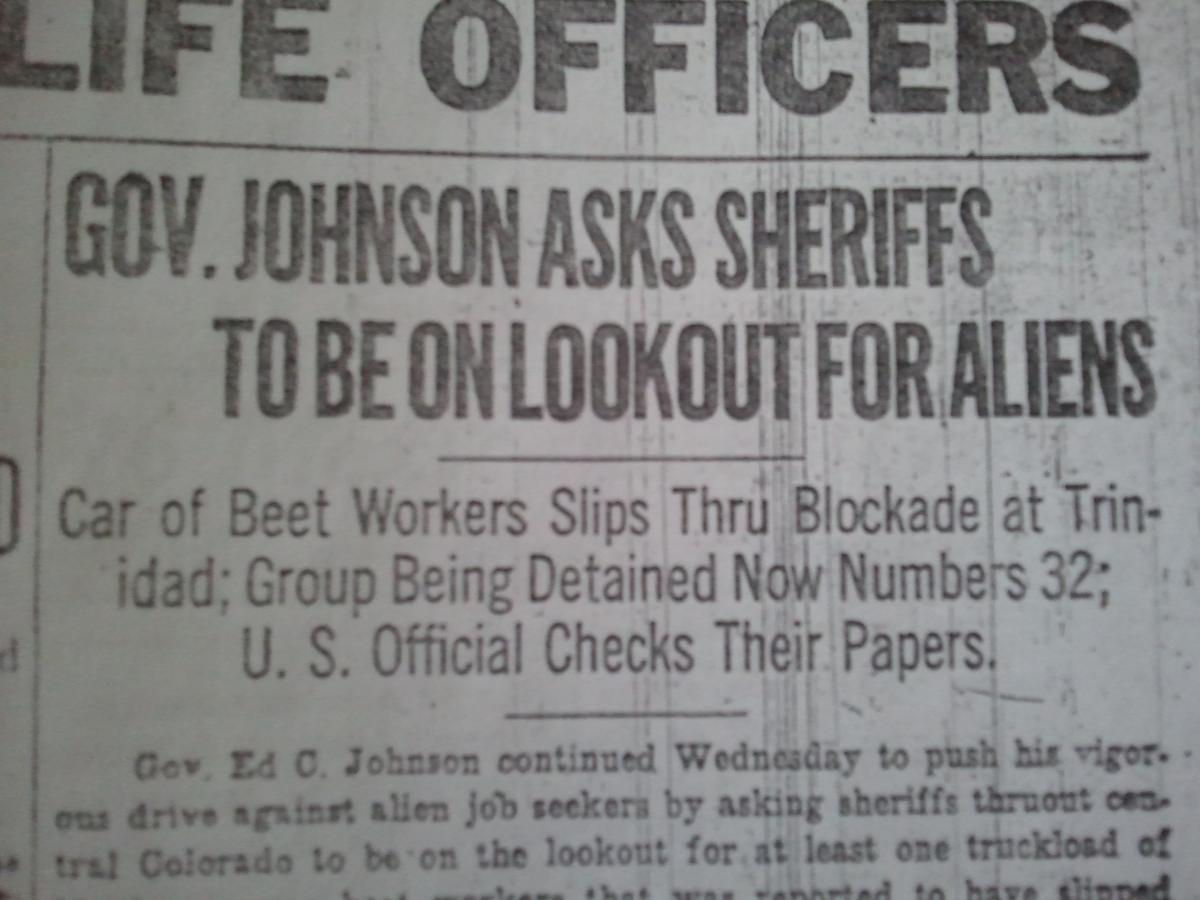
Denver Post, May 8, 1935
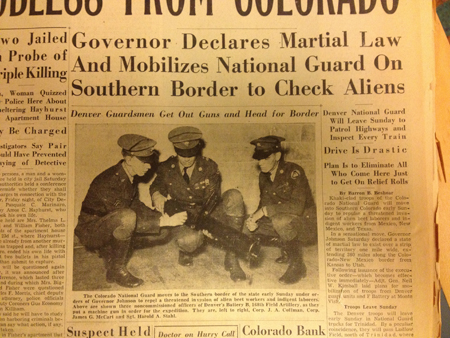
Rocky Mountain News, April 19, 1936
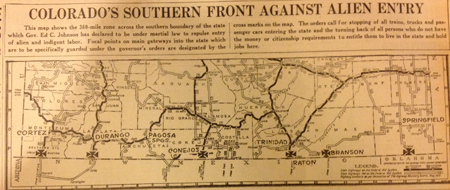
Denver Post, April 19, 1936.
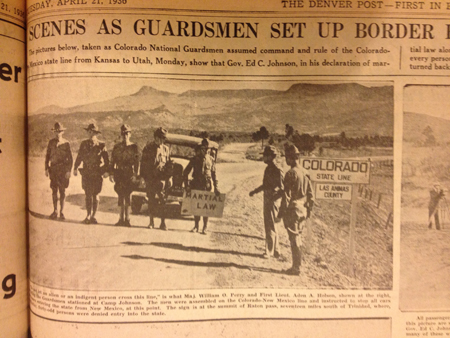
Denver Post, April 21, 1936
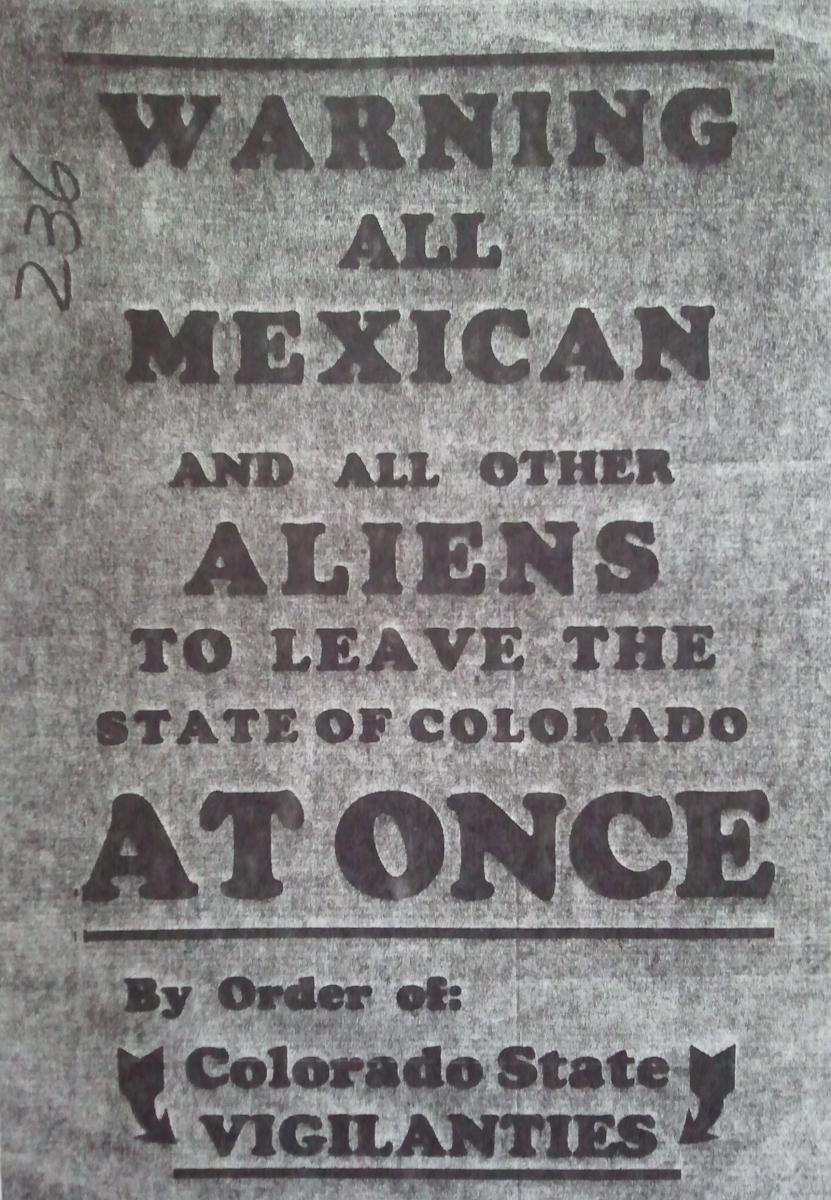
Flyer, Box 26916, Governor Edwin Carl Johnson Collection
Colorado State Archives
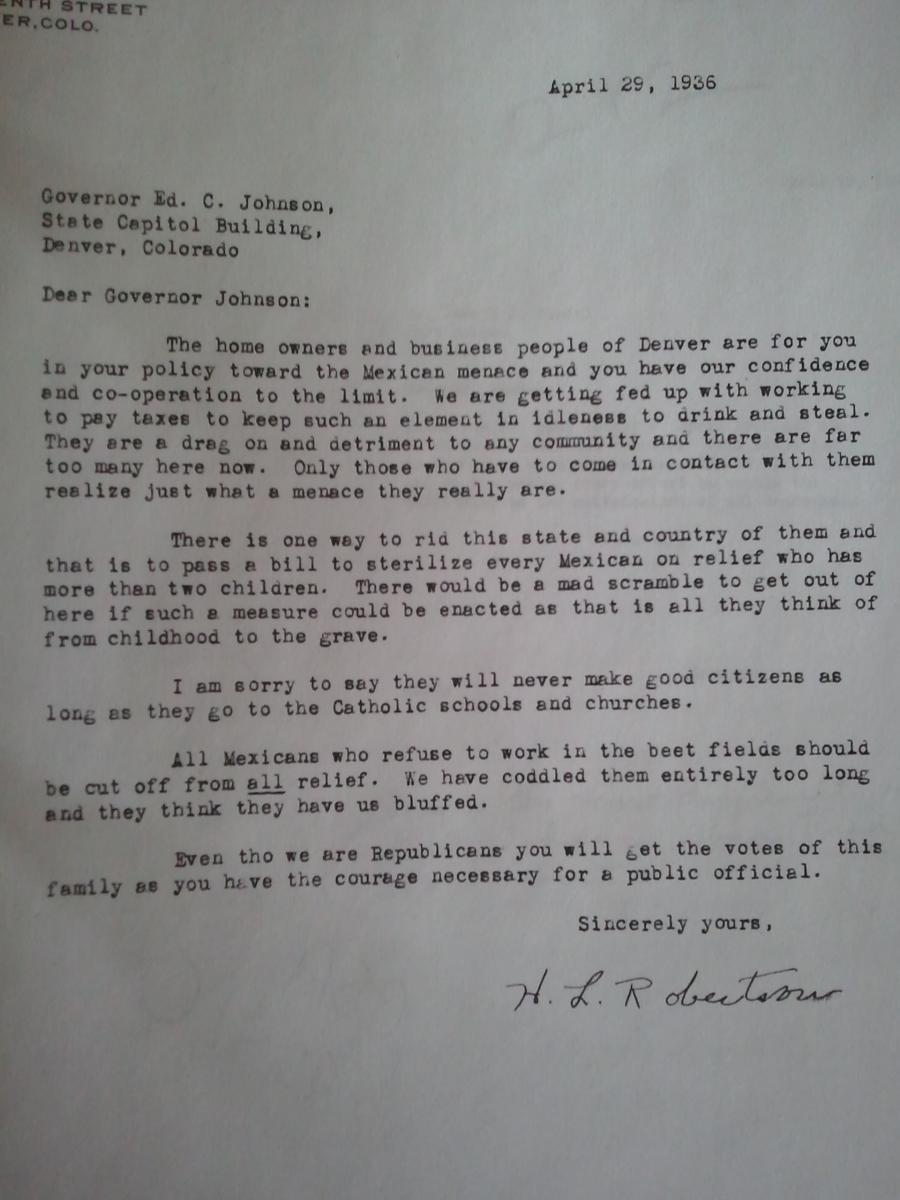
H.L. Robertson to Edwin C. Johnson, April 29, 1936, Box 26916
Governor Edwin Carl Johnson Collection, Colorado State Archives
The contemporary Juan Crow and the issues of immigration, criminality, detention, and marginalization are analyzed and critiqued in a variety of contexts. The best blog on the legal and policy implications of the intersection between crime and immigration is crImmigration.
Such issues are tied artistically together in this video by Manu Chao titled “Clandestino in Arizona.” Here, the militaristic brutality of laws like those passed in Arizon and several other states is put into sharp relief.
Maricopa County Sheriff, Joe Arpaio’s crusade against undocumented Mexicans symbolizes much of the excesses of local enforcement of federal immigration law against Latinos. As a result of his and his department’s actions, the Justice Department filed a lawsuit. The lawsuit was successful in part. This case and the other lawsuits against Arpaio point to the continuing war against the "Mexican Menace."
Marco Saavedra, an immigrants' rights activist, getting himself arrested and admitted into an immigration detention center in Florida.
Unsettling Citizenship/Circumventing Sovereignty: Re-examining the Quandries of Contemporary Colonialism in the U.S. Black Puerto Rican Anti-racist Thought
José I. Fusté
The essay weighs the uses and limitations of sovereignty and citizenship for the 7.3 million people who live in contemporary US colonies (i.e., reservations and “unincorporated territories”), where residents continue to be deprived of both political equality and the right to self-determination. It brings to light a series of little-known critiques written by two early twentieth-century Puerto Rican antiracist activist intellectuals, Tomás Carrión Maduro and Luis Felipe Dessus. By excavating the original ways in which these thinkers dispelled the notion that either full annexation or full separation from the United States would bring about substantive decolonization for race and class subalterns in the island, this piece aims to provoke those of us who today continue to grapple with the impasses of contemporary US colonialisms to chart alternative decolonial approaches by possibly “sidestepping” sovereignty and citizenship as the primary rallying banners of our struggles.
Related Links
A Huffington Post article by Maritza Stanchich (Professor of English at the University of Puerto Rico) provides a thorough explanation of the deadlocked Puerto Rican status referendum of 2012 and the other plebiscites that preceded it.
Also, a 2008 issue of Revista: The Harvard Review of Latin America has two short essays that expand on how we should be rethinking questions of citizenship and sovereingty in Puerto Rico in relation to anti-colonial and anti-racist politics. The first piece is by Ramón Grosfoguel (Associate Professor of Ethnic Studies, UC Berkeley) and is titled “Recolonization or Decolonization? The Neocolonial Project of the United States in Puerto Rico.” In it, Grosfoguel expands on what he thinks would be the benefits of “radical statehood.” This alternative, annexationist, anti-colonial approach was proposed by several intellectuals from the island in the 1990s, including Grosfoguel. Their argument (see an English translation of their 1997 manifesto here) is that Puerto Ricans in the island have consistently rejected independence because they fear that sovereignty will lead Puerto Rico to become a neo-colony of the United States. Instead of always defining leftism as automatically pro-independence, proponents of the radical statehood alternative invite those concerned about colonialism, capitalism, racism, and heteropatriarchy and the hierarchies of power they have created in the island to formulate an annexationist movement that does not put the United States on a pedestal but rather seeks to decolonize the U.S. empire from within. This proposal is reminiscent of what Tomás Carrión Maduro—one of the anti-racist, anti-colonial activists analyzed in this essay—proposed almost a century before.
For a provocative critique of the idea of radical statehood, see Chapter 1 of Shalini Puri’s The Caribbean Postcolonial, especially pages 30-41.
The second essay in this 2008 issue of Harvard’s 2008 Revista is by Mirian Jiménez Román, a scholar who has written about Afro-Latinidad in the U.S. and who is also the Executive Director of the “Afro-Latina/o Forum,” an organization devoted to creating awareness about the local, national, and transnational political and economic issues faced by Latina/os of African ancestry. This piece is relevant to the essay published here since it demonstrates how a century after black-identified Puerto Rican anti-racists like Carrión Maduro and Dessus critiqued the intersection of creole white suprmemacy and colonialism in the island, there is still virtually no acknowledgement among the Puerto Rico’s intelligentsia and political elites—including those on the Left—about the effects of anti-black racism on the island’s social structure. This speaks to the need for articulating contemporary critiques that continue to highlight the connection between U.S. imperialism and white supremacy in the island.
The Unequal Promise of Marriage Equality
Meg Wesling
The essay asks about the relationship between two important recent US Supreme Court decisions delivered in June 2013 and their import for the future of anti-racist queer political action. In particular, I’m interested in the current academic critiques of “marriage equality” campaigns and the ways that those critiques have struggled to articulate the complexity of marriage’s affective and ideological importance. I also share with those critical views a sense that the analogy between gay rights and civil rights is risky business, and that it works poorly as a shorthand for the complex relationship between those histories.
By way of background information, here are links to the two Supreme Court decisions that are under discussion in the essay.
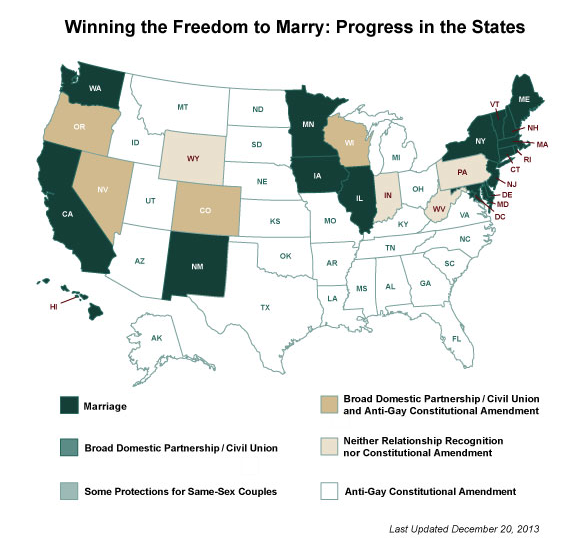
A U.S. map that illuminates the status of same-sex marriage in each state, as provided by the Freedom to Marry, Inc. 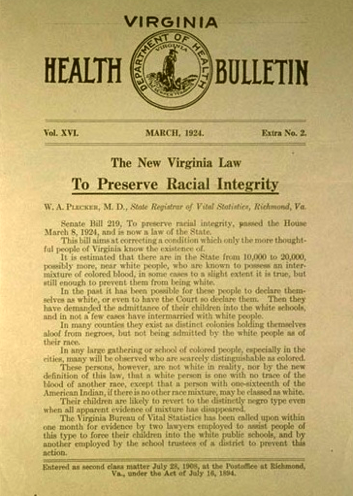
The backdrop to the United States v. Windsor case includes reference to Virginia's Racial Integrity Act of 1924. Virginia Health Bulletin announcing the Racial Integrity Act, 1924. Courtesy of the Eugenics Archives.
In the lead-up to the United States v. Windsor decision, President Obama announced (ABC news clip) that the Department of Justice would not defend the Defense of Marriage Act. Attorney General Eric Holder sent a letter to announce this decision.
The comparison between gay rights and civil rights is so ubiquitous that it is hard to name sources as such. That said, here are links to a few of the articles referenced in this essay, as well as a few more recent examples. There is, for example, a notable blog called “The New Civil Rights Movement” that follows legislation related to gays and lesbians in the US.
- “Is Same Sex the New Racism?”
- “Gay is the New Black?”
- “It’s Official: Gay is the New Black”
- “Is Gay the New Black? Debate from Marriage Ban”
The Legal Information Institute of Cornell University Law School offers a thorough reading of the Shelby County v. Holder decision, and offers some background data and research links.
One of the interesting things about the United States v. Windsor case is the way that Edith Windsor was chosen as an “ideal” candidate to represent the cause of marriage equality. The reasoning behind that decision is spelled out in the profile of Edith Windsor by Ariel Levy that appeared in the New Yorker on Sept. 30, 2013.
A compelling collection of essays argue against the centrality of “marriage equality” in political commitments for gay, lesbian, queer, and trans rights. Many of these express political commitments to a queer public life that are incommensurate with marriage in its perceived normative practices of bourgeois domesticity.
Finally, I would like to point readers to a relevant development in contemporary news. While the discussion about same-sex marriage continues, groups that oppose same-sex marriage rights have pressed for new legislation defending a business owner or individual’s “right” to refuse service to an individual perceived to be gay or lesbian. While several states have discussed such measures, only Arizona passed such a bill (HB 2153 and SB 1062) under the framework of “religious freedom.” The bill was vetoed by Arizona Governor Jan Brewer.
Andrew Sullivan’s analysis of this legislation focuses primarily on the system of Jim Crow segregation and its resurrection through the attempt to make legal business owners’ discrimination against gays and lesbians. Sullivan’s blog entry emphasizes this point by featuring a photograph of a lunch counter sit-in in Virginia in 1960.
